Unexpected Thoughts in the Holy Land:
Posted by Fr. JonathanApr 19
(Continuing the reflections and story of the pilgrimage to the Holy Land, it should be clear that what is written is something personal and may not be shared by other pilgrims in the same way. Also, if you come upon this blog for the first time, it may be wise to look at the introduction in last week’s blog, explaining why, for me, this pilgrimage, “In the Footsteps of Jesus”, 15-22 March 2012, was so special.)
When one is actually there, in the Holy Land, it is easy to start musing on the ‘Word’ who became ‘Flesh’ in Jesus, in unexpected ways. For example, what did Jesus look like? The question becomes much more pressing when in his homeland. On our pilgrimage, we were mostly pale-faced Anglo Saxons, and rather than our western European image, Jesus must have resembled the native Palestinians, in facial appearance. The image that many have of Jesus, me included, comes from the face on the Holy Shroud. There are Semitic people, whose faces look a little like the face on the Shroud, as one sees them, ‘up close’ in the Holy Land; however, I must say that the face on the Holy Shroud also has a familiar ‘European look’, to my eyes.
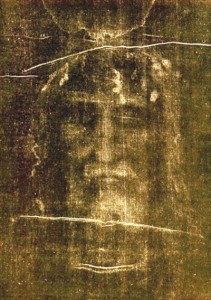 |
The Face on the Holy Shroud
On the other hand, here is a picture of a young Palestinian lad whom we met, and perhaps, Jesus looked more like him? I can imagine Matthew, the tax collector, looking like this young man. The question, however, is never very far from the surface of one’s mind, haunting away, and as you see the faces of more and more of the people, still the question remains: “Did Jesus look like one of these people?”
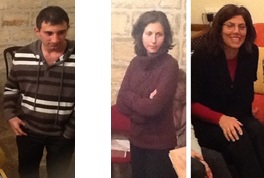 |
(1) The Young Palestinion Lad
(2) The Two Palestinian Girls from the Focolare
Similarly, one might ask what Mary’s appearance was like, as well. Above are two Palestinian girls, both from Haifa, and who are involved with the Focolare in the Holy Land. Do they give one an idea? Maybe this is an image of one of the other women in the gospels, if not Mary? Then, again, St. Joseph might have looked like the picture of this Palestinian craftsman working in his shop.
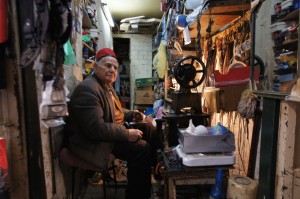 |
Palestinian craftsman in his workshop
Jesus spoke much, and performed many miracles, especially in a triangle of land around Capernaum – all in very close proximity. On our third day, our group went first to the Mount of the Beatitudes, where we celebrated Mass. The area is cared for by Franciscan Sisters, and when Laszlo, our young Hungarian guide, (see last week’s blog), and I, went to the sacristy, this loving, bustling, rather squat English speaking nun, spoke to us in Italian, and said: “No, your pilgrimage has been cancelled”, and sure enough, for the “Shepherd’s Tours”, there was a line through the booking. “Never mind”, she continued, “I will find a beautiful place for you”, and she was as good as her word. She led us to an altar in the open air, (as they all are, in that spot), where, despite the other pilgrims, we felt quite secluded, and there, in that ‘special’ place, we could meditate on the meaning of the ‘Beatitudes’.
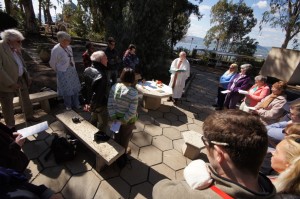 |
Mass at the Mount of the Beatitudes
Whilst there, we had the first of a number of shared sermons, and what people said was designed to ‘fit’ the place. In a kind of reflection, I found myself writing about this event:
“This time the mood of the moment hit me more strongly: yes, somewhere near here Jesus had spoken those amazing and revolutionary words; that people who are poor, meek, humble, those who weep, hunger and thirst for justice, or are persecuted, those who are suffering, in other words, are blessed. I wonder if that includes sinners. Sometimes I feel a bit of a failure, or a sinner, and indeed I am. Also, when others criticise me, or I criticise myself, either for failing to do what I should, or for acting in a way that Jesus would not, I also feel guilt. Blessed are those who mourn, they shall be comforted.
I love the fact, that the one who lived the Beatitudes best of all, was Mary, Mother of Jesus, the perfect disciple. The small Church is octagonal, and is quite beautiful; each side, around the altar, corresponds to a beatitude, and they are written in the windows above each octagonal wall. It is a spot with a wonderful view of the lake, and a place of peace, despite the bustling crowds of people, who eagerly go there, to see for themselves, and catch the spirit of it.”
 |
The Sea of Galilee, from the Mount of the Beatitudes
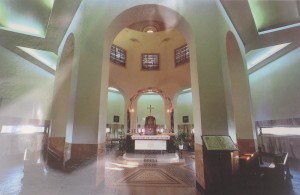 |
Inside the Church of the Beatitudes
The ‘ordinary’ moments of life also contributed much to the whole trip. After the Beatitudes, we went to Tabgha, where, traditionally, the site of the ‘Multiplication of the Loaves and Fishes’ took place – the feeding of the ‘Five Thousand’. I wanted to visit there, because I had not seen it, on my previous pilgrimage, and also because it is under the care of Benedictine monks – an offshoot of the monastery of the Dormition, in Jerusalem. However, by mistake, I had left our new (and costly) English Missal, back in the sacristy where we had celebrated Mass. To retrieve it, our driver, Sama, and I drove back, just the two of us, in our big coach, while the others visited Tabgha. It was ‘a happy mistake’ to have made, because Sama and I, had a good personal chat, and I began to understand the spirit of this good Moslem, who was so supportive of his Christian pilgrims. He was also so obliging, and friendly, ready to help any one of us, at any time. He told me he had not had much work that winter, but this should improve now that the ‘season’ was starting. Without tourism he would have no income, and nor would many others. Tourism, for him, means mainly Christian pilgrims. This was evident, especially in Bethlehem, and in many other places, too. When we drove through the part of Jerusalem where Sama lived, so many people waved, or greeted him, in his massive coach that negotiated the seemingly impossible, narrowest of gaps. He had to maintain a wife and family, and was so grateful for the work that came his way.
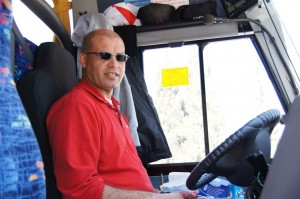 |
Our driver, Sama
Luckily, there was just time for a ‘whistle stop’ tour of the Church at Tabgha, where one can see the quite beautiful mosaics illustrating the story of the ‘loaves and fishes’:
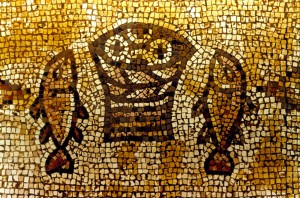 |
Mosaic at Tabgha
I had bought tiles of that mosaic, framed in wood, as presents for those who work in the Priory House. I was struck by how Jesus, was able to save an impossible situation – the feeding of the multitude, with only two fish, and five loaves of bread. How often each one of us finds oneself in an impossible situation, and yet, somehow we manage to get through it, if we let time pass, let good-will prevail and trust in God. It is a link to the miracle of the multiplication of the fish and the bread; for God nothing is impossible.
Another very inspiring story, from the gospels, is when Jesus – after his Resurrection – met the disciples, by the Lake of Galilee, very near to these two sites. Here, I found myself sitting by the water’s edge, listening to the lapping of water on pebbles, and eventually taking a few photos with my ‘ipad’, as people took in the scene, or paddled in the shallows.
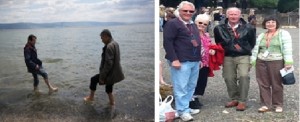 |
(1) Fellow pilgrims paddle in the Lake of Galilee
(2) Fellow Pilgrims at the Lake shore
It was here that Jesus affirmed Peter; Jesus had asked Peter three times: “Do you love me?” and Peter had assured his Master that he did. Peter was struck dumb by the goodness of Jesus, and the trust Jesus placed in him, despite Peter’s behaviour when he betrayed him three times at his arrest. This is the spot where it happened; it was also here that Jesus brought about the miraculous catch of fish, and there, he ate breakfast with the Apostles – a meal that He, himself, had cooked.
We all enjoyed a delicious lunch – delicious, as was all the food we ate – and at this, one can readily understand why the Jews had been told, that their land was a land flowing with milk and honey. After our meal, we went out on one of the famous “Jesus” boats, as they are called on the lake.
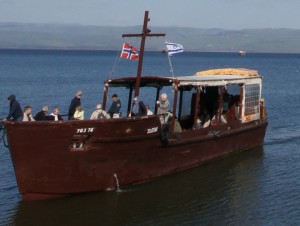 |
A ‘Jesus’ Boat
The crew were a jolly group, who played music for our entertainment; we even had our National Anthem – ‘God Save the Queen’ – and the ‘Union Jack’ on the boat.
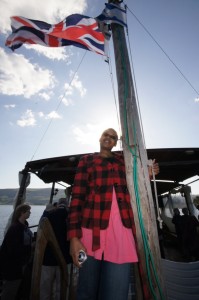 |
An African young girl, Mary in our group, with the Union Jack
Given the solidarity and feeling of unity that existed already amongst us, someone suggested we joined in an Israeli dance, which almost all of us duly did, gathering in a circle, and doing the simple steps, as we linked hands, and danced around.
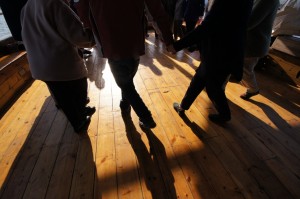 |
Learning the simple dance steps on the boat
However, the best of all came with the cutting of the engine, then simply sitting in the boat, the quiet sea all around us. So many thoughts came to mind, as one surveyed the hills, the landscape, picturing for oneself what Jesus, and the Apostles, must have seen. It was as if the two thousand years, between, had just disappeared into thin air. For many pilgrims, the Sea of Galilee is what they like most; truly, it is the most authentic place of all, where the scenery is unchanging – unchanged from the time of Jesus – preserved for us, today.
At this point, I feel that, for the moment, this is sufficient for this week’s blog. There is much more to share from the experiences of those memorable eight days in the Holy Land, and, relying on your continuing interest, I hope to be able to describe for you the rest of my story….
In sending out this blog by email, the original formatting will be disrupted. To view it in its original state readers are advised to visit the main blog site

No comments